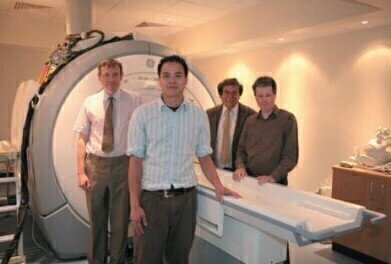News & Views
A New Scan for Lung Diseases
Feb 12 2010
People with chronic lung disease and asthma could soon benefit from use of a new type of Magnetic Resonance Imaging (MRI) scan being pioneered at The University of Nottingham. A purpose-built MRI research unit based at the Queens Medical Centre will allow doctors to virtually ‘see inside’ the lungs of patients who have inhaled a specially-treated harmless gas prior to an MRI scan. As well as giving a detailed picture of damaged and healthy areas of the lungs, the new method also shows the gas being absorbed into the bloodstream. This will give doctors a clear idea of how well or badly the different parts of the lungs are transferring life-sustaining oxygen. The scans could also be used to guide treatment or to guide surgeons performing lung reduction operations. The gas to be used in these trials is Xenon 129, which is said to be easy to obtain and offers potential for clinical use. The Xenon is ‘hyperpolarised’ using lasers which make the gas particles detectable in the MR scanner.
The team of scientists and clinicians at the University has won around £3 million from a range of sources to fund the building of the tailormade facility at the Queen’s Medical Centre. It will also pay for clinical trials of the technique and to develop better hyperpolarisation equipment to supply the gas needed. A new member of staff, physicist Professor Thomas Meersman, has been appointed from Colorado State University to help lead the
hyperpolarisation research.
The project is being led by Professor Ian Hall in the medical school and Professor Peter Morris, Director of the Sir Peter Mansfield MRI Centre. Professor Hall said: “This research has huge implications for the treatment and monitoring of lung disease. We are very excited to be able to combine our world-renowned MRI knowledge with the clinical expertise at the Queen’s Medical Centre in Nottingham to try and develop hyperpolarised xenon MRI as the diagnostic and therapeutic monitoring tool of choice for lung-related diseases in the future.”
The project has been jointly funded by the Engineering and Physical Sciences Research Council, GE Healthcare, the Medical Research Council, the Wolfson Foundation, East Midlands Development Agency and The University of Nottingham. The Wolfson Foundation has also helped to fund infrastructure developments at the Sir Peter Mansfield Magnetic Resonance Centre on University Park to enable further research into improving the process of hyperpolarisation of Xenon 129 and also to investigate the use of other gases like Krypton. Clinical trials on the use of hyperpolarised Xenon/MRI in healthy volunteers are planned to start in the next few months followed by trials involving patients with COPD and lung fibrosis. Anyone interested in volunteering for the trials can contact the research team on 0115 9709783.
Digital Edition
Lab Asia 31.2 April 2024
April 2024
In This Edition Chromatography Articles - Approaches to troubleshooting an SPE method for the analysis of oligonucleotides (pt i) - High-precision liquid flow processes demand full fluidic c...
View all digital editions
Events
Apr 28 2024 Montreal, Quebec, Canada
May 05 2024 Seville, Spain
InformEx Zone at CPhl North America
May 07 2024 Pennsylvania, PA, USA
May 14 2024 Oklahoma City, OK, USA
May 15 2024 Birmingham, UK






.jpg)











